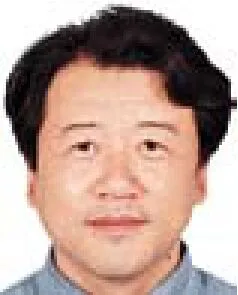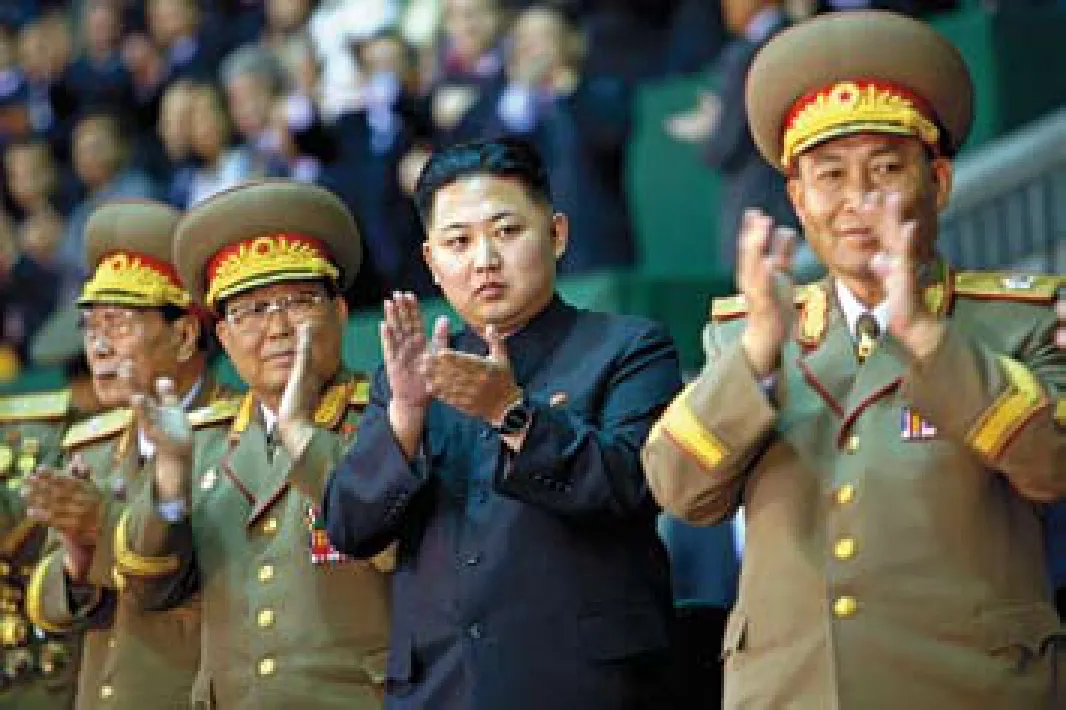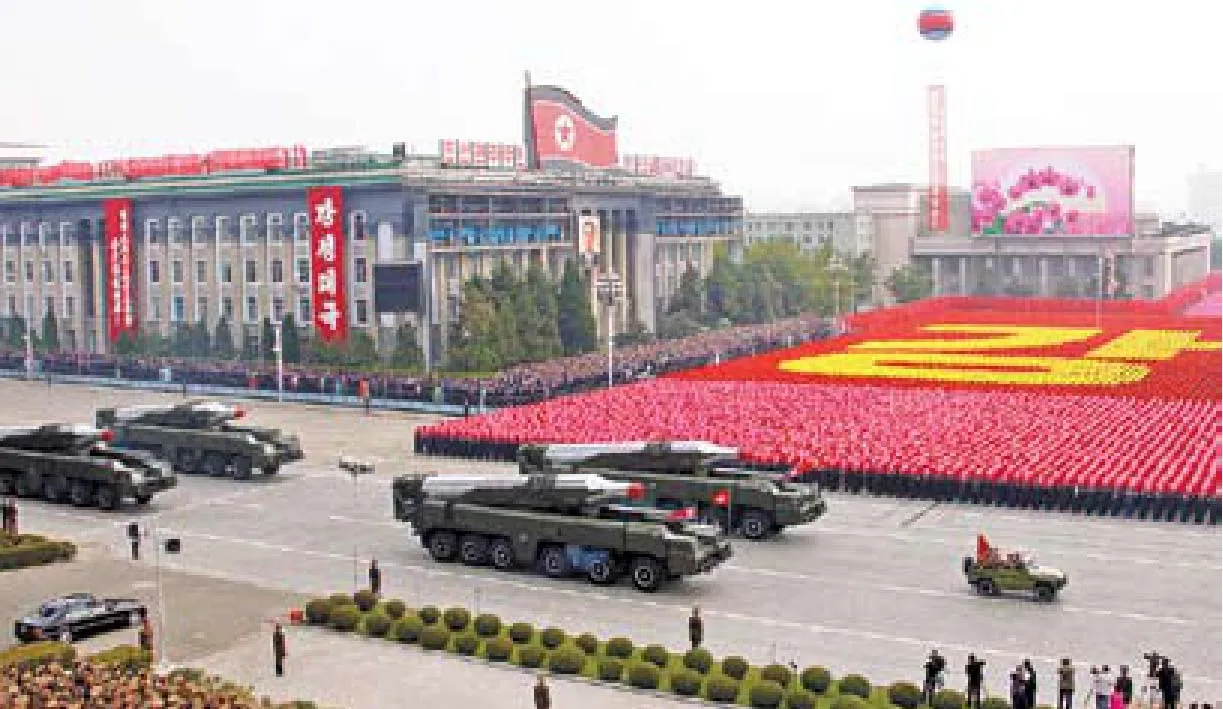Pyongyang’s Choice
2010-10-14BySHIYONGMING
By SHI YONGM ING
Pyongyang’s Choice
By SHI YONGM ING
North Korea’s ruling party confirms new leadership to increase the country’s stability T he recent leader-

ship ad justment in the Democratic People’s Republic o f Korea (DPRK) w as one of the world’s most attention-grabbing affairs.A conference for the ruling Workers’ Party of Korea (WPK) was successfully held on September 28. A day before the conference, Kim Jong Il, the DPRK’s top leader, issued an order that promoted a group of military officers. Kim’s youngest son Kim Jong Un was appointed a general. These activities prove the DPRK has established its new leadership.
Seeking stability
Though the United States declined to comment on the leadership adjustment, it is watching closely. Critics from the Republic of Korea (ROK) said the DPRK has had an heirbased leadership system for three generations,with pretty negative consequences. The ROK side believes such a system could lead to the internal instability of the DPRK and has actively planned to cope with emergency. Seoul said the odds of a bursting event in the DPRK have increased. The ROK has structured a plan,preparing to accept large numbers of DPRK refugees in the event of such an occurrence.
The WPK meeting and m ilitary order were an attempt to maintain the country’s political stability. The DPRK collapse theory has been around since the end of the Cold War. After the DPRK’s former top leader,Kim Il Sung, died in 1994—and as the country was hit by natural disasters in the follow ing years—the theory gained prominence. When reports about Kim Jong Il’s health condition were released in August 2008, the theory again became popular.
The DPRK did have some problems in its leadership structure. Four of the five members of the Standing Comm ittee of the Political Bureau of the WPK Central Committee then had passed away, making the leadership very unsound. Among the aging leadership, there were few young or m iddleaged individuals. In such an environment, a leader’s health is representative of the country’s stability; this is why Kim Jong Il’s health was so significant. Therefore, the adjustment,enrichment and perpetuation of its leadership were at the top of the DPRK’s agenda.
The September conference strengthened the WPK’s leadership. Those at the conference elected a new WPK Central Committee and Political Bureau, enriched the WPK’s leadership, promoted experienced and vigorous officials and selected young and middleaged cadres. In this way, current leadership can continue.
The WPK Constitution was also amended.According to a report from the country’s official news agency, the Korean Central News Agency, the resolution of the WPK conference said now is an important historic point and the country must strengthen the WPK’s leadership. The amendments stressed the WPK’s leadership in the country, while pledging to enhance the party’s role in the military.
The conference hinted that the WPK’s leadership will be further strengthened in both political and military aspects. Such a leadership structure is more stable than the previous one, so the country’s political uncertainties should be greatly reduced.
Im p roving live lihoods
The outside world had two major questions about the WPK conference. First, can the heir system guarantee political stability?Second, how w ill the country develop in the future? Since the country’s leadership is now fairly stable, the key concern is the country’s policy choices.
For the DPRK, the top task is to seek a balance between the development of a national defense force and the promotion of the national standard of living. One DPRK policy the Western world strongly condemns is its Songun (m ilitary-first) policy, which Kim Jong Il advanced in January 1995. The Songun policy was born at a time when Western countries were propagandizing the DPRK collapse theory and Seoul was advocating ROK-led reunification. After dispatching troops to Iraq in 2003, George W. Bush’s U.S. administration posed a threat to the DPRK; this only pressed the development of the Songun policy.
The Songun policy has since made great achievements. A fter two nuclear tests, the DPRK clearly has nuclear deterrence. And the world now has a new take on the DPRK’s m ilitary strength, after a m ilitary parade celebrating the WPK’s 65th anniversary on October 10. Many weaponry systems, like theNodong, scud and surface-to-air missiles, were displayed during the parade. The country’s new mid-range missile,Musudan, debuted in the parade, in front of media representatives from around the world—including from the United States—who were invited to the DPRK parade. The public appearance by Kim Jong Il’s son was also eye-grabbing, but the weapons gained most of the world’s attention. This parade showed the country’s counter-invasion ability is much greater than in the 1990s.
The enhanced m ilitary strength creates opportunities to invest more resources into developing a lively economy. However, it is the decision of DPRK leaders whether or not to perm it this transfer. The DPRK proposed 2012 as a target for becoming a strong country. The target is multifaceted: The country hopes to gain military strength and be unafraid of foreign threats, while creating a high standard of living. Its people would be able to live high-quality lives and would no longer be jealous of citizens of other countries. So after the country has reached certain military achievements, the leadership should make the rational choice of improving lives.
A fter the Korean W ar (1950-53), the DPRK’s economy had solid grow th. Beforethe ROK’s economy took off, the DPRK’s per-capita GDP was higher than that of the ROK’s. Since the end of the Cold War, though,the DPRK’s economy has been sliding. In the mid-1990s, the country’s economy was even worse due to numerous natural disasters. In the 1980s, the country’s annual grain production once reached 10 million tons. But in the mid-1990s, its annual grain production was about 3 million tons. The country’s economy has generally recovered in recent years, but grain production is still limited. It had a good harvest in 2005, but still produced just 4.5 million tons. Reports said the DPRK predicted its grain production in 2010 to possibly exceed 5 million tons. But with a population of 23 million, the country needs 4 million tons just to feed its people. Counting other necessities, like grain seeds, fodder and industrial material, the DPRK needs at least 6 million tons of grain;this leaves the country w ith a grain shortage of 2 million tons. Living standards w ill hardly be improved if a steady grain supply cannot be guaranteed.

(Le ft)NEW BLOOD: Kim Jong Un (second right),new ly e lec ted Vice Chairm an o f the Central M ilitary Comm ission o f the Wo rkers’ Party o f Ko rea (WPK), attends a perfo rm ance celeb rating the 65th anniversary o f the WPK’s found ing in Pyongyang on Oc tober 9
The country is actively developing agriculture and is importing a large amount of grain to meet needs. But there are only 1.85 million hectares of agricultural fields in the country. And due to serious soil erosion caused by natural disasters, most fields are barren. The largest problem for the country’s agriculture,though, is a lack of industrial support.
Add ressing sanc tions
The DPRK has put too many resources into the military. The consequence has been insufficient agricultural infrastructure facilities, technologies, machinery and fertilizer,all of which are vital to agricultural development. To address the livelihood problem, the country must make econom ic development its national focus. However, whether or not such a transfer can be realized is closely connected w ith external environment changes and the DPRK’s opinion on such changes.
It is true that Western econom ic blockades against the DPRK—stemm ing from the nuclear issue—have limited the country’s econom ic development. Improving the external environment is a tough task for Pyongyang moving forward.
Before the WPK conference, some ROK media outlets guessed policies related to reform and opening up might be proposed.The guess was impractical, as the top problem for the DPRK is the external blockade.In fact, the DPRK began to entertain opening up near the end of the Cold War. For example, its government established the Rajin-Sonbong free trade zone in 1991. The program developed well in the m id-1990s,but stalled soon after. In the early 21st century, the country tried to reform its economic operations and develop comprehensive diplomacy, so as to develop relations w ith European countries and receive foreign investment.
In addition to domestic policy, international political elements also limited the country. When Kim Da Jung and Roh Moo Hyun were ROK presidents from 1998 to 2008, they im plemented active policies w ith the DPRK, which helped improve the DPRK economy. But as DPRK-ROK political relations continued to deteriorate, their economic relationship froze. The sinking of the ROK warshipCheonanon March 26 dealt a further blow to the ROK-DPRK relationship.
In mid-October, the DPRK said it was w illing to restart the six-party talks aimed at resolving the Korean Peninsula nuclear issue, hoping to break international limitations to its econom ic development. But when and how the talks reopen cannot be decided by a single party; the United States and the ROK play equally important roles in the negotiations. In the meantime, the DPRK must make a clear strategic choice on whether or not it w ill abandon its nuclear program.Nevertheless, the elim ination of external limitations and the improvement of living standards w ill be great tests for the country’s new leadership.
The author is an associate research fellow w ith the China Institute of International Studies

M ILITARY STRENGTH: A grand m ilitary parade is he ld in Pyongyang on Oc tober 10 to celebrate the 65th anniversary o f the found ing o f the WPK
